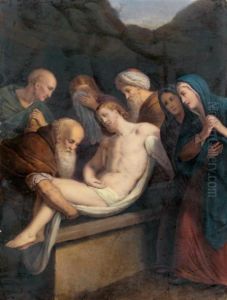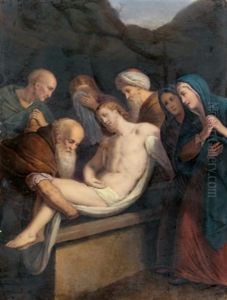Giuseppe Longhi Paintings
Giuseppe Longhi was an Italian engraver and printmaker born on January 3, 1766, in Monza, Lombardy. He was a prominent figure in Italian engraving during the late 18th and early 19th centuries. Longhi initially trained under his father, but he soon moved to Milan to study at the Brera Academy. There, he was a pupil of the esteemed engraver Giuseppe Bossi, who was known for promoting the neoclassical style in art.
After his education, Longhi's skill and reputation grew, and he became known for his fine line engravings and stipple work. He produced engravings after the works of renowned artists such as Raphael, Guido Reni, and Titian, as well as contemporary artists of his time. His engravings were celebrated for their delicacy, precision, and the successful conveyance of the original paintings' effects.
One of Longhi's most significant contributions to the art world was his role in education. He became a professor at the Brera Academy, where he had once been a student. Through his teaching, he influenced a generation of Italian engravers and printmakers. Additionally, he wrote an important treatise on engraving techniques, 'La Calcografia' (The Chalcography), which became a valuable resource for artists and historians.
Longhi's work was not limited to reproductions of paintings. He also created original portraits, book illustrations, and even designed banknotes. His portrait engravings included prominent figures of his time, such as Napoleon Bonaparte and Vittorio Alfieri, the famous Italian dramatist.
Despite his success, Longhi's life was not without challenges. The Napoleonic Wars and the changing political landscape of Italy affected his career, as the demand for luxury items like fine engravings diminished. Nevertheless, Longhi's legacy endured through his students and the high standards he set for Italian printmaking.
Giuseppe Longhi passed away on February 2, 1831, in Milan. His death marked the end of an era for the classicist tradition in Italian engraving, but his works continue to be appreciated for their technical excellence and artistic beauty. Longhi's engravings can be found in numerous collections and museums around the world, serving as a testament to the enduring appeal of his craft.

